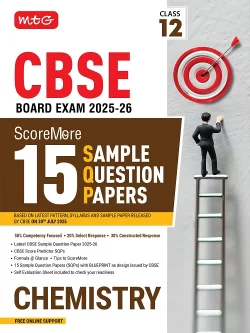The all new CBSE resource – Chapterwise Instant Notes is based on the new, revised and rationalized CBSE syllabus. This book ensures that CBSE students have the perfect revision material right by their side. After preparing the whole chapter and finishing the practice, it’s not possible and nor is it feasible for students to go through the whole chapter again in the name of revision. Therefore, it’s best if they stick to a small book that provides them quick revision whenever they want.
- Quick recap notes in each chapter.
- Complete chapter presented in the form of subjective questions.
- Complete coverage of the latest CBSE syllabus.
- The long questions and answers cover the whole chapter in a thorough manner.
Table of Content:-
CLASS 12
Volume 1
Chapters
1. Solutions
– Types of Solutions
– Expressing Concentration of Solutions
– Solubility
– Vapour Pressure of Liquid Solutions
– Ideal and Non-ideal Solutions
– Colligative Properties and Determination of Molar Mass
– Abnormal Molar Masses
2. Electrochemistry
– Electrochemical Cells
– Galvanic Cells
– Nernst Equation
– Conductance of Electrolytic Solutions
– Electrolytic Cells and Electrolysis
– Batteries
– Fuel Cells
– Corrosion
3. Chemical Kinetics
– Rate of a Chemical Reaction
– Factors Influencing Rate of a Reaction
– Integrated Rate Equations
– Temperature Dependence of the Rate of a Reaction
– Collision Theory of Chemical Reactions
4. The d- and f-Block Elements
– Position in the Periodic Table
– Electronic Configurations of the d-Block Elements
– General Properties of the Transition Elements (d-Block)
– Some Important Compounds of Transition Elements
– The Lanthanoids
– The Actinoids
– Some Applications of d- and f- Block Elements
5. Coordination Compounds
– Werner’s Theory of Coordination Compounds
– Definitions of Some Important Terms Pertaining to Coordination Compounds
– Nomenclature of Coordination Compounds
– Isomerism in Coordination Compounds
– Bonding in Coordination Compounds
– Bonding in Metal Carbonyls
– Importance and Applications of Coordination Compounds
CLASS 12
Volume 2
Chapters
6. Haloalkanes and Haloarenes
– Classification
– Nomenclature
– Nature of C — X Bond
– Methods of Preparation of Haloalkanes
– Preparation of Haloarenes
– Physical Properties
– Chemical Reactions
– Polyhalogen Compounds
7. Alcohols, Phenols and Ethers
– Classification
– Nomenclature
– Structures of Functional Groups
– Alcohols and Phenols
– Some Commercially Important Alcohols
– Ethers
8. Aldehydes, Ketones and Carboxylic Acids
– Nomenclature and Structure of Carbonyl Group
– Preparation of Aldehydes and Ketones
– Physical Properties
– Chemical Reactions
– Uses of Aldehydes and Ketones
– Nomenclature and Structure of Carboxyl Group
– Methods of Preparation of Carboxylic Acids
– Physical Properties
– Chemical Reactions
– Uses of Carboxylic Acids
9. Organic Compounds Containing Nitrogen
– Structure of Amines
– Classification
– Nomenclature
– Preparation of Amines
– Physical Properties
– Chemical Reactions
– Cyanides and Isocyanides
– Method of Preparation of Diazonium Salts
– Physical Properties
– Chemical Reactions
– Importance of Diazonium Salts in Synthesis of Aromatic Compounds
10. Biomolecules
– Carbohydrates
– Proteins
– Enzymes
– Vitamins
– Nucleic Acids
– Hormones


 Free delivery in India for orders over Rs. 1,100.00.
Free delivery in India for orders over Rs. 1,100.00.






















